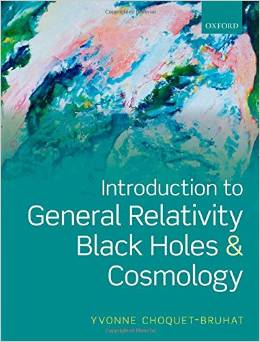I got another book recently, this time from the Oxford Press. I was looking forward to reading this one. I have a great interest in cosmology and I was curious about some of the recent discoveries about cosmology and physics. The author, Yvonne Choquet-Bruhat comes highly recommended in physics circles.
Introduction to General Relativity, Black Holes and Cosmology
First of all, the physical book itself is of acceptable quality. While a softcover book, the cover is sturdy and the printing is such that the majority of the book can be read while keeping the book on the table and the spine from breaking (a particular pet peeve of mine, which is why I never by paperbacks at used book stores). The paper is crisp and very white, which is perhaps the source of my one serious complaint.
The book smells. Not in that old, musty book way or the new book smell of clean paper, but in a highly clinical, very stringent way. After many days, it smells alternately vinegary and like fish. It’s definitely a little off-putting. Perhaps the hardcover would be better and certainly the Kindle edition wouldn’t smell. However, I am very curious as to how the Kindle edition presents the text.
This, make no mistake, is a textbook, with sample problems and everything. It’s mostly written in the older style (like I had growing up). Divide each page into three columns. The text spans the two innermost columns. The outer column is used for “footnotes” and the subchapter headings on each chapter title page. I certainly don’t mind the format, but it’s not a format for a casual reader.
The book itself is also not for a casual reader… or even an intermediate reader like myself. The blurb text for the book contains this sentence
This introductory textbook is written for mathematics students interested in physics and physics students interested in exact mathematical formulations (or for anyone with a scientific mind who is curious to know more of the world we live in), recent remarkable experimental and observational results which confirm the theory are clearly described and no specialised physics knowledge is required. The mathematical level of Part A is aimed at undergraduate students and could be the basis for a course on General Relativity. Part B is more advanced, but still does not require sophisticated mathematics.
This is, shall we say, wildly optimistic. I am not a neophyte when it comes to math. But I am not a math major either (thank Cthulhu). If you are not a math major, then this book is not for you. Let me give you an example.
The fundamental arena of differential geometry is a differentiable manifold. For the physicist, the most concrete and useful definition makes apparent the local identification of a manifold with Rn, the space of sets of n real numbers with its usual topology. The definition proceeds as follows.
Then is gets really deep. Now, you’re probably thinking, that doesn’t sound too bad. Yes, well… those are the second, third, and fourth sentences in the book proper.
I’m sure for people with training in tensors, tensor fields, pseudo-Riemmannian metrics, the Linearized Ricci tensore, and geodesics will find the first chapter (and possibly, the other nine chapters) of the book fascinating. For me, it was of marginal value.
In the small areas of the book with text, there were some definitely odd choices of grammar, which also put me off a bit. It made me feel like I was missing something, but all research and indications to the contrary, I wasn’t.
I was actually disappointed in the coverage of black holes and cosmology. Despite the title of the book and the blurb that I mentioned earlier, there was only a single chapter (out of ten) that discussed cosmology. It was really a discussion of the derivation of some models of cosmology from General Relativity. The book explicitly did not cover recent fomulations and a higher discussion of the principles of cosmology at all. Also, despite the title, the book only spent one chapter on black holes (with a second chapter on Scharzschild spacetime).
Both of those chapters had some interesting text that was easily followed by myself. But it was certainly not a discussion of any new and really interesting science from the recent work in the field.
It is a very specific book on General Relativity and it’s relationship to the universe.
It’s a fascinating topic for experts and lay-readers alike. But this book is for a very specific audience. And if you aren’t that audience (that automatically understand manifold space), then I would suggest looking elsewhere for a treatment of the topic.

